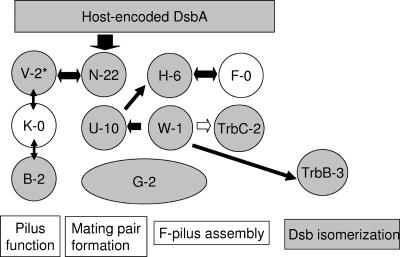FIG. 4.
A representation of possible interactions in the F pilus assembly and mating pair formation system. The proteins for F pilus assembly and mating pair formation are divided into three groups: those that are highly conserved among T4SS and are involved in pilus assembly and function (TraV, -K, and -B), F-T4SS proteins involved in mating pair stabilization (TraN, -U, and -G), and F-T4SS proteins involved in pilus assembly (TraF,-G [N-terminal region], -H, and -W and TrbC). DsbA is known to affect pilus assembly (10) and TraN stability (39). Host-encoded DsbC and -G may be involved in disulfide bond isomerization (not shown) as might be F TrbB. For the R27 plasmid, DsbC and HtdT might also be involved (not shown). The number of cysteines is shown after each protein (single letter for Tra proteins), indicating a potential for disulfide bond formation. Proteins with no cysteines are emphasized in white. The possible interactions between the proteins are summarized according to Harris and Silverman (31). White arrows indicate inferred interactions from sequence data for TrbC and TraW, which are fused into one protein in R27 (42).

